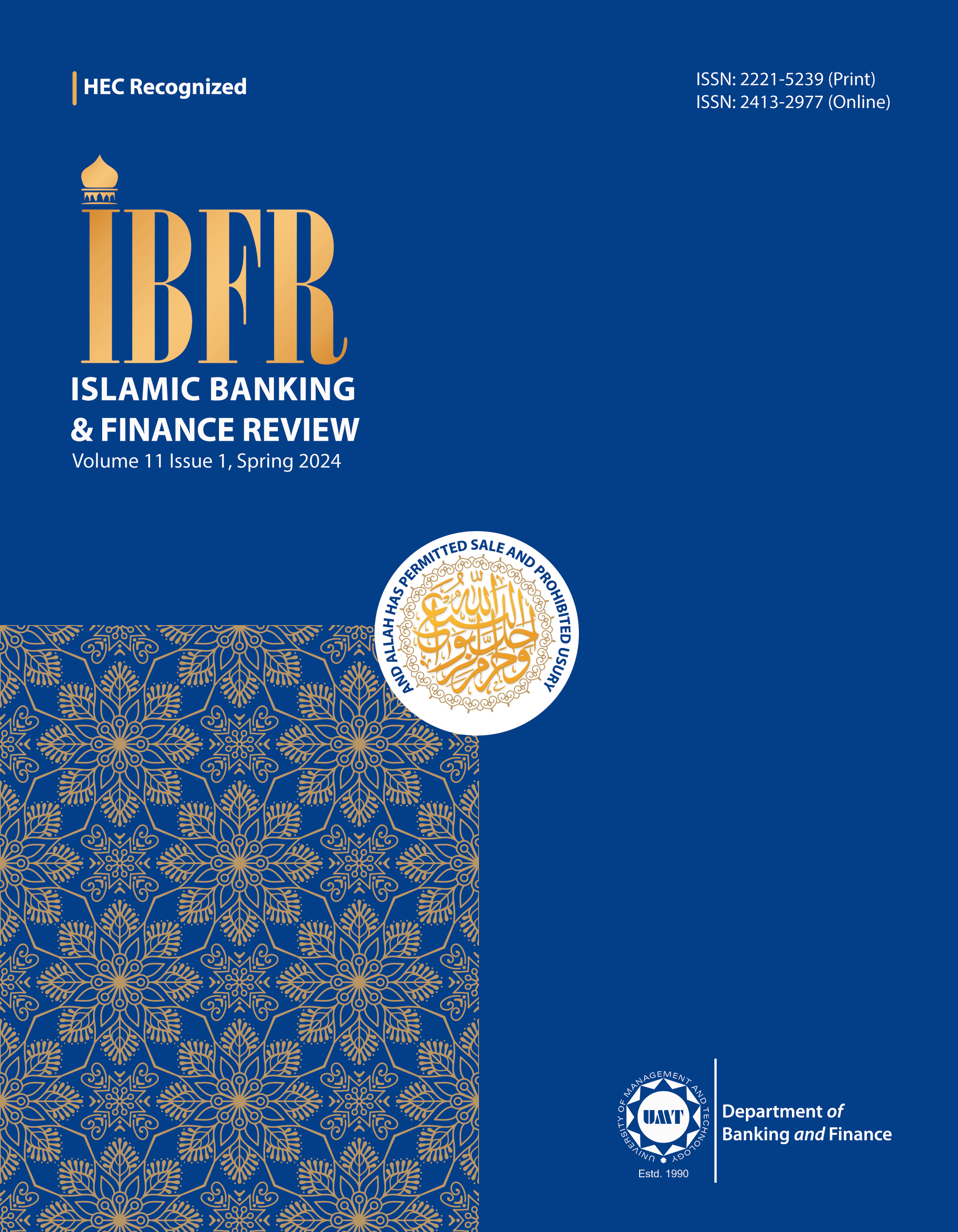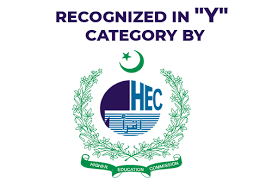Federal Shariat Court’s Judgment on Ribā-Free Economy of Pakistan: Challenges in Implementation and the Way Forward
Abstract
 Abstract Views: 0
Abstract Views: 0
This paper explores the challenges in implementing the Federal Shariat Court (FSC) judgment on the Ribā-free economy of Pakistan. This study employs the Qualitative Content Analysis (QCA) method to analyze the data gathered through semi-structured interviews with various stakeholders, including Shariah scholars, Islamic economics and finance researchers, Islamic bankers, and central bankers. The findings suggest that the conversion of the existing large public sector debt (higher than the current GDP of Pakistan) to Shariah-compliant modes of financing is the most significant challenge ahead of Pakistan’s government. The next potential challenge to the government is what it would do in case international donors (IMF, World Bank, Paris Club) do not lend money through Islamic modes of financing. Moreover, monetary policy management by the State Bank of Pakistan (SBP) in the Islamic banking system also remains a challenge. All these challenges can be addressed if the Pakistani government issues Sukūk instead of issuing T-Bills more frequently and in large quantums. Additionally, the government can get funding through the capital market. An alternative strategy might be to issue project-linked, equity Sukūk that generate new assets, rather than using existing assets to issue Sukūk. The findings may help the Government of Pakistan in the smooth transition of its current economy to a Ribā-free economy. Once Pakistan’s economy is completely Islamized, then other Muslim countries may follow Pakistan in transitioning their economies as well. To the best of the authors’ knowledge, this study is the first of its kind, which has identified the main challenges that may arise in implementing the FSC judgment. Moreover, few suggestions have been made to address such challenges.
Downloads
References
Ahmad, K. (1981). Studies in Islamic Economics. Leicester: The Islamic Foundation.
Akhtar, A., & Zia, I. (2022, January 25). The Analytical Angle: Need for Youth-Centered Sustainable Economic and Social Growth in Pakistan. DAWN. https://www.dawn.com/news/1671262.
Al-Tamimi, H. A. H., & Al-Amiri, A. (2003). Analyzing Service Quality in the UAE Islamic Banks. Journal of Financial Services Marketing, 8(2), 119-132. https://doi.org/10.1057/palgrave.fsm.4770112.
Amin, T. (2022a, September 20). Wheat Imports Put Big Strain on Forex Reserves: ADB. Business Recorder. https://www.brecorder.com/news/40198528/wheat-imports-put-big-strain-on-forex-reserves-adb.
Amin, T. (2022b, September 23). WB Confirms Fears of Growing Food Insecurity. Business Recorder. https://epaper.brecorder.com/2022/09/23/1-page/943237-news.html.
Asad, M. (2014). The Road to Mecca. London: The Book Foundation.
Ayub, M. (2007). Understanding Islamic Finance. London: John Wiley & Sons.
Azam, A., & Shafique, M. (2017). Agriculture in Pakistan and its Impact on Economy-A Review. International Journal of Advanced Science and Technology, 103, 47-60. https://doi.org/10.14257/ijast.2017.103.05.
Baxter, P. & Jack, S. (2008). Qualitative Case Study Methodology: Study Design and Implementation for Novice Researchers. The Qualitative Report, 13(4), 544–559.
Bhutto, A. W., Bazmi, A. A., & Zahedi, G. (2012). Greener Energy: Issues and Challenges for Pakistan-Hydel Power Prospective. Renewable and Sustainable Energy Reviews, 16(5), 2732–2746.
Brown, T. (2008). Design Thinking. Harvard Business Review, 86(6), 1–10.
Business Recorder. (2022, September 23). SAI Calls for End to Daily Outages of Eight Hours. Business Recorder. https://www.brecorder.com/news/amp/40199110.
Council of Islamic Ideology. (1980). Report of the Council of Islamic Ideology on the Elimination of Interest from the Economy. Islamabad: Council of Islamic Ideology.
Crone, P. (1987). Meccan Trade and the Rise of Islam. Oxford: Blackwell.
DAWN. (2022a, August 26). Structural Problems (Editorial). DAWN. https://www.dawn.com/news/1706865.
DAWN. (2022b, April 22). Economic Challenges (Editorial). DAWN. https://www.dawn.com/news/1686227.
DAWN. (2022c, January 31). State Bank’s Role (Editorial). DAWN. https://www.dawn.com/news/1672431.
Elo, S., & Kyngas, H. (2008). The Qualitative Content Analysis Process. Journal of Advanced Nursing, 62(1), 107–115.
https://doi.org/10.1111/j.1365-2648.2007.04569.x.
Faisal v. Govt. of Pakistan, XLIV Federal Shariat Court (1992). http://giveupriba.com/wp-content/uploads/2017/08/Federal-Shariat-Court-Judgement-on-Riba-1992.pdf.
Ghafoor, Z. (2022). Federal Sharıah Court’s Judgment for Riba Free Pakistan. Journal of Islamic Business and Management, 12(1), 1–4. https://doi.org/10.26501/jibm/2022.1201-001.
Hameedullah, M. (n.d.). Interest-Free Cooperative Lending Societies. In S. M. Jamil, & M. Khan (Eds.), The Muslim Year Book, India and Who’s Who with Complete Information on Pakistan, 1948-49 (pp. 491–496). Bombay: The Bombay Newspaper Co. Limited.
Haque, Z., & Gardezi, H. N. (1991). Islamization of Economy in Pakistan (1977-88): An Essay on the Relationship between Religion and Economics [with Comments]. The Pakistan Development Review, 30(4), 1105–1118. http://www.jstor.org/stable/41259524.
Hickey, G., & Kipping, C. (1996). Issues in Research. A Multi-Stage Approach to the Coding of Data from Open-Ended Questions. Nurse Researcher, 4, 81–91
Hsieh, H. F., & Shannon, S. E. (2005). Three Approaches to Qualitative Content Analysis. Qualitative Health Research, 15(9), 1277–1288.
Husain, I. (2004). The Economy of Pakistan: Past, Present, and Future. In R. M. Hathaway & W. Lee (Eds.), Islamization and the Pakistani Economy (pp. 11–35). Washington DC: Woodrow Wilson International Center for Scholars.
Islahi, A. A. (2018). History of Islamic Banking and Finance. Intellectual Discourse, 26(2), 403-429.
Islahi, A. A. (2015). “The Genesis of Islamic Economics” Revisited. Islamic Economic Studies, 23(2), 1-28. https://doi.org/10.12816/0015019.
Ismail, M. [@MiftahIsmail]. (2022, April 28). We welcome the Federal Shariat Court (FSC) decision in the Riba case. The Government and SBP will carefully study this important decision and then seek guidance and clarification from the FSC about the process, steps, and timeframe to implement this decision [Tweet]. Twitter. https://twitter.com/MiftahIsmail/status/1519582531062009856.
Janjua, M. A. (2003). History of the State Bank of Pakistan [Vol. 3 (1977-1988)]. Karachi: State Bank of Pakistan.
Kahf, M. (2004). Islamic banks: The Rise of a New Power Alliance of Wealth and Shariah Scholarship. In C. M. Henry & R. Wilson (Eds.), The Politics of Islamic Finance (pp. 17–36). Edinburgh: Edinburgh University Press.
Kennedy, C. H. (1990). Islamization and Legal Reform in Pakistan, 1979-1989. Pacific Affairs, 63(1), 62–77. https://doi.org/10.2307/2759814.
Kiani, K. (2022, September 13). Pakistan Lacking ‘Effectiveness’ on Four FATF-Linked Goals. DAWN. https://www.dawn.com/news/1709836.
Khan, M. S., & Mirakhor, A. (1990). Islamic Banking: Experiences in the Islamic Republic of Iran and Pakistan. Economic Development and Cultural Change, 38(2), 353-375. http://www.jstor.org/stable/1154031.
Kohlbacher, F. (2006). The Use of Qualitative Content Analysis in Case Study Research. Forum: Qualitative Social Research, 7(1), 1–30.
Kondracki, N. L., & Wellman, N. S. (2002). Content Analysis: Review of Methods and Their Applications in Nutrition Education. Journal of Nutrition Education and Behavior, 34, 224–230.
Kuran, T. (2004). Islam and Mammon: The Economic Predicaments of Islamism. Princeton: Princeton University Press.
Laldin, M. A. (2008). Islamic Financial System: The Malaysian Experience and the Way Forward. Humanomics, 24(3), 217-238. https://doi.org/10.1108/08288660810899377.
Mansoori, T., & Ayub, M. (2022). Federal Shariah Court’s Judgement on Ribā: An Appraisal and Some Suggestions. Journal of Islamic Business and Management, 12(1), 5-17. https://doi.org/10.26501/jibm/2022.1201-002.
Mayring, P. (2000). Qualitative content analysis. Forum: Qualitative Social Research, 1(2), 1–10.
Mehmood, A. (2002). Islamisation of Economy in Pakistan: Past, Present, and Future. Islamic Studies, 41(4), 675–704. http://www.jstor.org/stable/20837235.
Moretti, F., van Vliet, L., Bensing, J., Deledda, G., Mazzi, M., Rimondini, M., ... & Fletcher, I. (2011). A Standardized Approach to Qualitative Content Analysis of Focus Group Discussions from Different Countries. Patient education and counseling, 82(3), 420-428.
National Assembly of Pakistan. (2018). The Constitution of the Islamic Republic of Pakistan [Modified to May 31, 2018]. Islamabad: National Assembly of Pakistan. https://na.gov.pk/uploads/documents/1549886415_632.pdf.
Nouman, M., Ullah, K., & Jan, S. (2022). Domains and motives of Musharakah spur in the Islamic banking industry of Pakistan. The Singapore Economic Review, 67(01), 381-409.
Nizamani, S. (2021, December 26). Jobless Youth. DAWN. https://www.dawn.com/news/1665806.
Nouman, M., Ullah, K., & Jan, S. (2022). Domains and Motives of Musharakah Spur in the Islamic Banking Industry of Pakistan. The Singapore Economic Review, 67(01), 381-409. https://doi.org/10.1142/S0217590819500620.
Pasha, H. A. (2022, September 20). Human Development Index: Pakistan falls. Business Recorder. https://www.brecorder.com/news/40198480/human-development-index-pakistan-falls.
Potter, W. J., & Levine-Donnerstein, D. (1999). Rethinking Validity and Reliability in Content Analysis. Journal of Applied Communication Research, 27(3), 258–284.
Rehman, H., & Shahzad, M. A. (2020). Analysis of the Efforts Made by Constitutional Institutions for Elimination of Ribā from Pakistan. Islamabad Law Review, 3(1-2). https://doi.org/http://dx.doi.org/10.2139/ssrn.3549501
Saeed, H. A., & Mulhim, M. H. (2016). Mawsuah Ahadith Ahkam al-Muaamalat al-Maliyah (Arabic). Riyadh: al-Bayan.
SBP. (1948). Quaid-i-Azam's Speech on the occasion of the Opening Ceremony of
The State Bank of Pakistan on July 1, 1948. State Bank of Pakistan. Retrieved September 23, 2022, from https://www.sbp.org.pk/about/history/h_moments.htm.
SBP. (1984). BCD (Banking Control Department) Circular No. 13. State Bank of Pakistan. Retrieved September 25, 2022, from https://www.sbp.org.pk/departments/pdf/IBD-OldCircular/BCD-cir13-1984.pdf.
Schreier, M. (2012). Qualitative Content Analysis in Practice. London: Sage.
Watt, W. M. (1953). Muhammad at Mecca. Oxford: Clarendon Press.
Yin, R. K. (2003). Case Study Research: Designs and Methods. Thousand Oaks, CA: Sage Publications.
Zia, M. A., Abbas, R. Z., & Arshed, N. (2021). Money Laundering and Terror Financing: Issues and Challenges in Pakistan. Journal of Money Laundering Control, 25(1), 181–194. https://doi.org/10.1108/JMLC-11-2020-0126.
Copyright (c) 2024 Rafiullah Sheikh, Abdul Rashid, Muhammad Ayub

This work is licensed under a Creative Commons Attribution 4.0 International License.
Authors retain copyright and grant the journal right of first publication with the work simultaneously licensed under a Creative Commons Attribution (CC-BY) 4.0 License that allows others to share the work with an acknowledgement of the work’s authorship and initial publication in this journal.












